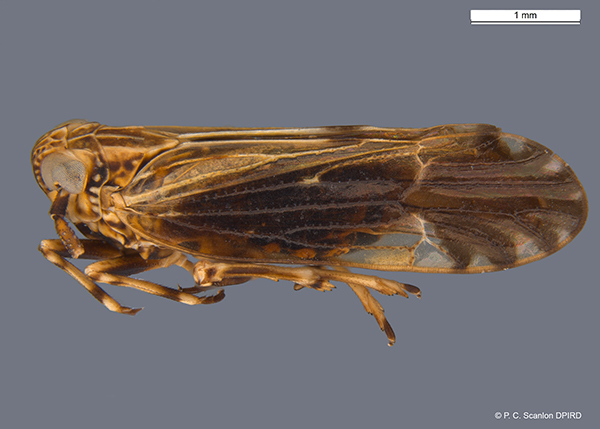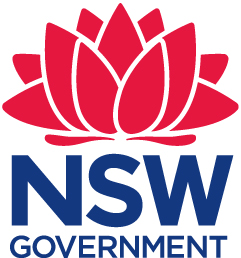*Biosecurity threat, not present in Australia
Perkinsiella spp
Sugarcane planthoppers
Caution
Many of the insects depicted on these pages are outwardly similar and you should not use photographs as the sole means of identification. These pages form part of a scientific key which will assist a trained entomologist to identify the species accurately.
Perkinsiella bakeri Muir, 1916
*Perkinsiella bicoloris Muir, 1911
*Perkinsiella diagoras Fennah, 1979
Perkinsiella graminicida Kirkaldy, 1906
*Perkinsiella lalokensis Muir, 1911
*Perkinsiella papuensis Muir, 1911
*Perkinsiella rattlei Muir, 1911
Perkinsiella saccharicida Kirkaldy, 1903
*Perkinsiella sinensis Kirkaldy, 1907
Perkinsiella thompsoni Muir, 1916
*Perkinsiella vastatrix (Breddin, 1896)
*Perkinsiella vitiensis Kirkaldy, 1906
Common Name: Sugarcane Planthoppers
Subfamily/Tribe: Delphacinae: Delphacini
Distribution: Perkinsiella are predominantly tropical in distribution. The records given here are taken from Bartlett (2018) and Bourgoin 2018 and, for Australia, Bellis et al. (2013) and Bellis unpublished data).
- Perkinsiella saccharicida is the most widespread and appears to be dispersing globally. It has been recorded from Australia (Qld, NSW), USA (including Hawaii and southern mainland states), Mexico, Guatemala, Georgia, Columbia, Costa Rica, Ecuador, Peru, Cuba, Venezuela, Thailand, Vietnam, India, Japan, Malaysia, Indonesia, Fiji, Taiwan, China, Mauritius, Philippines, Papua New Guinea, Reunion Island, Madagascar, Cameroon, Swaziland and South Africa (African records: Harris 1970).
- Perkinsiella vastatrix has been collected in Indonesia, Malaysia, Philippines, Papua New Guinea, Taiwan, Japan and East Africa.
- Perkinsiella sinensis also has a wide distribution, being recorded from China, Borneo, Japan, Taiwan, India, Micronesia, Indonesia and Papua New Guinea.
- Perkinsiella vitiensis has been found in Fiji, Polynesia and Samoa.
- Perkinsiella thompsoni is in Guam, western Micronesia, Indonesia, Timor-Leste, Taiwan, Papua New Guinea and Australia (WA, NT).
- Perkinsiella graminicida occurs in Australia (Qld), and may occur in Japan (Ryukyu Islands – Bartlett 2018), Fiji and the Philippines (Dupo and Barrion 2009), but the latter three country records of P. graminicida require substantiation.
- Perkinsiella bakeri occurs in Australia (WA, NT), Japan (Ryukyu Islands), Philippines, Taiwan, Vietnam, and western Caroline Is (Bartlett 2018).
- Species with more restricted distributions include P. lalokensis, P. papuensis, P. bicoloris, P. diagoras and P. rattlei from Papua New Guinea, with P. rattlei also recorded from New Caledonia.
Economic Status: The main economic host of the Perkinsiella species treated here is sugarcane, although some species can feed on other crops, notably rice, sorghum and maize. Perkinsiella vastatrix was, for example, included on the Plant Health Australia (2015) contingency plan for exotic sap-sucking insects of grains for its effect on maize and sorghum. Most of the exotic species listed here have, however, been identified as high priority threats to Australia’s sugarcane industry (Plant Health Australia 2018). Perkinsiella saccharicida, P. vastatrix and P. vitiensis are vectors of Fiji disease of sugarcane, also known as Fiji leaf gall (Bartlett 2018). Other species listed here may have the potential to transmit Fiji disease, but further work is required to resolve this with any certainty. Fiji disease is present in Australia albeit restricted to southern cane growing areas (Ridley et al. 2006).
Notes: There are 35 species of described Perkinsiella globally (Bartlett 2018), with only four present in Australia (P. saccharicida, P. graminicida,P.thompsoni and P.bakeri). Perkinsiella have various patterns on the forewings and frons, which together can give an indication as to species identity. However, definitive species identification should be based on the male genitalia.

Perkinsiella thompsoni Muir [image: M.J. Fletcher]

Perkinsiella rattlei Muir [Image: Pia Scanlon, DPIRB, WA]
